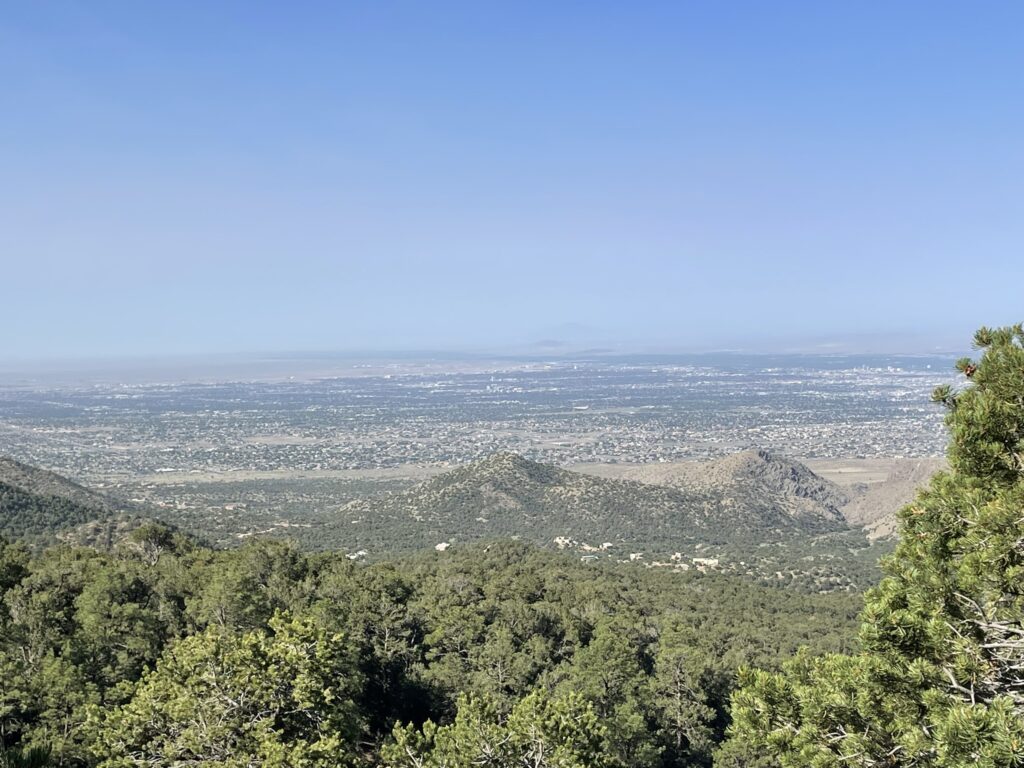Altitude’s impacts on runners come not from having less oxygen, but less pressure, allowing all the oxygen molecules to spread out. I have lived at around 5,500′ (more than a mile) for close to 30 years, but I still feel the effect of the dispersed oxygen molecules when go into an up the Sandias here in Albuquerque. To learn more about altitude’s impacts on runners and what they are, scroll down.

The Air Up There: A Runner’s Guide to Conquering Altitude
You’ve done it. You’ve signed up for that bucket-list race in the Rockies, planned a running vacation in the Andes, or maybe you’re just visiting family in a city that’s a little closer to the clouds. You’ve trained for the distance, but have you trained for the altitude?
Running at elevation presents a unique and humbling challenge. The miles feel harder, your breath is shorter, and your GPS watch is telling you a pace that feels more like an all-out sprint. So, what’s going on? Let’s break down the science of high-altitude running and how you can prepare to conquer it.
The Science: It’s Not Less Oxygen, It’s Less Pressure
Here’s the most common misconception about altitude: that there is “less oxygen” in the air. The percentage of oxygen () in the atmosphere is actually consistent at about 21%, whether you’re at sea level or on top of a mountain.
The real culprit is barometric pressure.
At sea level, the air is dense. The column of air pushing down on you is taller, so the pressure is higher. This high pressure effectively crams oxygen molecules closer together. With every breath you take, you get a dense, rich serving of .
As you ascend in altitude, the column of air above you shortens, and the barometric pressure drops. This allows all the air molecules, including oxygen, to spread out. So, while the percentage of oxygen is still 21%, each lungful you take contains fewer oxygen molecules. This is often referred to as a lower “partial pressure of oxygen.”
Your body, which is a finely-tuned machine for sea-level living, immediately notices this oxygen deficit.
Your Body’s Reaction: The Scramble for Oxygen
When your body detects it’s getting less oxygen per breath, it kicks into high gear to compensate:
- Immediate Response (The First 24-72 Hours):
- Increased Breathing Rate (Hyperventilation): Your body’s first and fastest response is to try and take in more air. You’ll find yourself breathing more rapidly, even at rest.
- Increased Heart Rate: Your heart has to work harder to pump the less-oxygenated blood around your body to deliver the necessary fuel to your muscles and organs. An easy pace at sea level might push you into your tempo heart rate zone at altitude.
- Long-Term Adaptation (Acclimatization): If you stay at altitude, your body makes more profound changes.
- Your kidneys release more of a hormone called Erythropoietin (EPO).
- EPO signals your bone marrow to produce more red blood cells.
- These new red blood cells act like extra taxis for oxygen, increasing your blood’s oxygen-carrying capacity. This is the “magic” of altitude training, but it takes weeks, not days, to fully realize.
Practical Tips for Running at Altitude
Understanding the science is one thing, but running through it is another. Here’s how you can make your high-altitude running experience safer and more enjoyable.
1. Arrive Early
This is the golden rule. If you’re racing, try to arrive at least 3-5 days beforehand to give your body a chance to start the acclimatization process. If you can arrive a week or more in advance, even better.
2. Hydrate, Hydrate, Hydrate!
The air at altitude is very dry. You lose a significant amount of water through respiration (all that heavy breathing!). Dehydration can mimic and worsen symptoms of altitude sickness. Drink water consistently throughout the day, even when you don’t feel thirsty.
3. Adjust Your Pace and Expectations
Forget the numbers on your watch. Run by effort, not by pace. An “easy” day should feel easy, even if that means you’re running two minutes per mile slower than you would at sea level. Pushing too hard too soon is a recipe for exhaustion and can lead to Acute Mountain Sickness (AMS).
4. The First Days Are for Acclimatization
Your first 1-2 days at altitude should involve very light activity. Think a short, slow jog or even just a walk. Don’t jump right into your hard tempo run or interval workout.
5. Fuel with Carbohydrates
Your body relies more heavily on carbohydrates as a fuel source at altitude. Make sure you’re taking in enough quality carbs to keep your energy levels up.
6. Listen To Your Body
This is paramount. Dizziness, unusual fatigue, headaches, and nausea are signs of Acute Mountain Sickness (AMS). Don’t try to “run through it.” If you experience these symptoms, stop, rest, hydrate, and if they persist or worsen, descend to a lower altitude.
7. Protect Yourself from the Sun
The thinner atmosphere at altitude filters fewer UV rays. You can get a sunburn much faster than at sea level. Apply sunscreen liberally, wear a hat, and use sunglasses.
The Payoff: Returning to Sea Level
The reward for all this hard work comes when you return home. After spending time training with less available oxygen, your body is now a super-efficient oxygen-delivery machine packed with extra red blood cells. Running at sea level will feel noticeably easier, your breathing will be controlled, and you may just find yourself hitting new personal records.
So next time you head for the hills, go with respect for the elevation. Slow down, drink up, and listen to your body. You’ll not only survive the run, but you’ll come back stronger for it.



